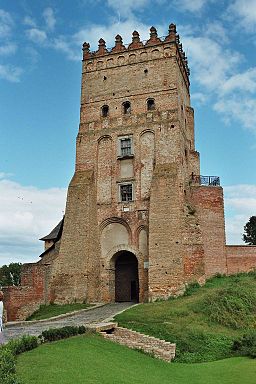Volhyn
| Volhynia (Волинь) | ||
| Historical Region | ||
|
Lubart's Castle (Lutsk) was the seat of the medieval princes of Volhynia.
|
||
|
||
| Countries | Ukraine, Poland, Belarus | |
|---|---|---|
| Regions | Western Ukraine, Eastern Poland | |
| Parts | Volyn Oblast, Rivne Oblast, Zhytomyr Oblast, Ternopil Oblast, Khmelnytskyi Oblast, Lublin Voivodeship, Brest Region | |
| Landmark | Pochayiv Lavra | |
| Rivers | Horyn River, Styr River, Prypiat River, Western Bug River | |
| Highest point | Povcha Upland | |
| - elevation | 361 m (1,184 ft) | |
| Lowest point | Polesia | |
| - elevation | 130 m (427 ft) | |
|
Volhynia (yellow) in modern Ukraine
|
||
Volhynia, Volynia, or Volyn (Ukrainian: Волинь, Volýn′, Russian: Волы́нь, Volyn′; Polish: Wołyń, Lithuanian: Voluinė or Volynė; Czech: Volyň, Hungarian: Volhinia, German: Wolhynien or Wolynien (Volhynian German: Wolhinien or Wolinien), Yiddish: Volin װאָלין) is a historic region in Central and Eastern Europe straddling Poland, Ukraine, and Belarus. The alternate name for the region is Lodomeria after the city of Volodymyr-Volynsky (Vo-Lodymer), which once was a political capital of the medieval Volhynian Principality. It has changed hands numerous times throughout history and been divided among competing powers. Since the fall of the Soviet Union in 1991, it has been part of the independent nation of Ukraine.
Geographically it is located in the Volhynian-Podolian Upland section of the vast East European Plain, between the rivers Prypyat and Western Bug. Relative to other historical regions, it is northeast of Galicia, east of Lesser Poland, and northwest of Podolia. The borders of the region are not clearly defined, and it is often considered to overlap a number of other regions, among which are Polesia and Podlasie.
...
Wikipedia



